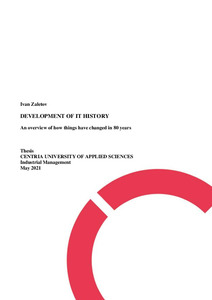The Rising Trends in Remote Healthcare Technology: A Scoping review
Asikele, Joyce (2025)
Asikele, Joyce
2025
All rights reserved. This publication is copyrighted. You may download, display and print it for Your own personal use. Commercial use is prohibited.
Julkaisun pysyvä osoite on
https://urn.fi/URN:NBN:fi:amk-2025083124301
https://urn.fi/URN:NBN:fi:amk-2025083124301
Tiivistelmä
Introduction: Technology is revolutionizing the way healthcare is delivered. Healthcare technology has become advanced so that it can be used in the comfort of our homes.
Remote health technology offers such solutions to having real-time monitoring, with advanced technologies such as artificial intelligence (AI), wearable devices and Internet of Things (IoT). However, studies on the challenges of using these technologies are prevalent as compared to the opportunities it provides.
This scoping review aims to map existing literatures on the rising trends in remote healthcare technologies, identify challenges and opportunities that healthcare system or providers face in implementing remote health services, and highlight gaps in current literature that needs to be addressed.
Method: A literature search was conducted in three databases, Google scholar, PubMed, and Institute of Electronic and Electrical Engineering (IEEE), with a pre-defined inclusion criteria (full text published articles in English from 2014 to 2024) to identify relevant data for this study. The JBI’s three-step search strategy for a scoping review was used.
Result: overall, 4297 studied were found, and 21 studies was selected for the review after applying the inclusion and exclusion criteria. The details of the search process was illustrated with a modified PRISMA-ScR f low chart following the PRISMA guidelines for conducting a scoping review. Using the thematic analysis to report the challenges identified, four themes (data privacy and security, interoperability and integration of challenge, personalized and patient-centered care, and regulatory and ethical concerns) were identified, with two sub-themes for each identified themes.
Conclusion: Remote health technology has seen remarkable growth in the last 10 years. The emergence of artificial intelligence (AI), wearable device , and Internet of Things (IoT) has revolutionized the way healthcare is delivered. Though there are obvious challenges to the use of remote healthcare technology, one needs to believe in future of the opportunities these device will bring as technological advancement is constant.
Remote health technology offers such solutions to having real-time monitoring, with advanced technologies such as artificial intelligence (AI), wearable devices and Internet of Things (IoT). However, studies on the challenges of using these technologies are prevalent as compared to the opportunities it provides.
This scoping review aims to map existing literatures on the rising trends in remote healthcare technologies, identify challenges and opportunities that healthcare system or providers face in implementing remote health services, and highlight gaps in current literature that needs to be addressed.
Method: A literature search was conducted in three databases, Google scholar, PubMed, and Institute of Electronic and Electrical Engineering (IEEE), with a pre-defined inclusion criteria (full text published articles in English from 2014 to 2024) to identify relevant data for this study. The JBI’s three-step search strategy for a scoping review was used.
Result: overall, 4297 studied were found, and 21 studies was selected for the review after applying the inclusion and exclusion criteria. The details of the search process was illustrated with a modified PRISMA-ScR f low chart following the PRISMA guidelines for conducting a scoping review. Using the thematic analysis to report the challenges identified, four themes (data privacy and security, interoperability and integration of challenge, personalized and patient-centered care, and regulatory and ethical concerns) were identified, with two sub-themes for each identified themes.
Conclusion: Remote health technology has seen remarkable growth in the last 10 years. The emergence of artificial intelligence (AI), wearable device , and Internet of Things (IoT) has revolutionized the way healthcare is delivered. Though there are obvious challenges to the use of remote healthcare technology, one needs to believe in future of the opportunities these device will bring as technological advancement is constant.
Kokoelmat
Samankaltainen aineisto
Näytetään aineisto, joilla on samankaltaisia nimekkeitä, tekijöitä tai asiasanoja.
-
Development of IT history : An overview of how things have changed in 80 years
Zaletov, Ivan (2022)The aim of this thesis was to describe the moving trends in the Information Technology industry from the point of view of history. It is assessed by specialists that the nonstop movement of IT and science has simplified ... -
The Impact Of Modern Communication Technology on the Quality Of Life Among the Elderly
Kariuki, Josphat Muiruri (2018)Adoption of communication devices and technologies among elderly people has been on the increase in recent past. These devices and technologies can be put to better use to enhance elderly’s QOL. This research project aimed ... -
The effect of Information and Communication Technology on trade and Supply chain management in Finland and the United Arab Emirates
Kassem, Zakarea (2022)ICT has had a significant impact on supply chain management in Finland and UAE, but there remain several challenges, including implementation costs, technical literacy and skill deficiencies, security concerns, and the ...



